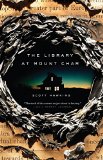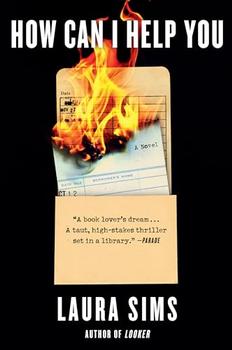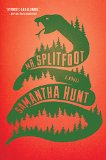Summary | Excerpt | Reviews | Beyond the book | Read-Alikes | Genres & Themes | Author Bio

From the opening scene of The Library at Mount Char, when Carolyn, a librarian, walks "blood-drenched and barefoot" down the road that "the Americans called Highway 78," readers are immersed in a rampaging and original fantasy full of violent surprises, that nevertheless engages the intellect.
In the world of Hawkins' imagination, Carolyn is one of twelve people, adopted as children by a man they call "the Father," each trained in a different branch of knowledge, known as their "catalogue." Each child has grown up learning from the books that their "Father" keeps in the Library at Mount Char, in the town of Garrison Oaks. Carolyn's area of expertise, for example is languages, while Michael can talk to animals and Peter's catalogue is mathematics and engineering. But other children, collectively called the Pelapi (or pupils) by their Father, have more gruesome areas of specialty: Jennifer can bring the dead back to life and David's catalogue is murder and war. Of all the wide cast of characters in The Library at Mount Char, David is a truly horrifying creation, dressed in only an Israeli Army flak jacket and "a lavender tutu, crusty with blood." Worse, as we learn early on, he likes to squeeze the blood from the hearts of his victims into his hair so that "over time, the combination of hair and blood hardened into something like a helmet." Carolyn, from her early murderous actions, may not seem like an obvious heroine, but compared to David, she certainly is.
What is this world, and where is the brutal Father who rescued these children in some way but then used and violently abused them? Now, not only is their father gone, they can also no longer access the library which has been their home. From the outset, Carolyn's motives are hard to understand. There is a bigger picture at play here. In a world where the dead can be resurrected time and time again, who knows what Carolyn will find if she manages to survive the zombie town of Garrison Oaks and gain access to the library at Mount Char? Late in the novel, as the answers to these questions are revealed, a character turns to Carolyn in disbelief about what she's telling him, saying, "You guys really are playing at just a completely other level. You know that?" In his concept and description of the library in question, Hawkins similarly takes his ideas to a completely different place. This is a collection like no other — it's the Willy Wonka Chocolate Factory of libraries — and a destination well worth the violence to be stomached before the reader arrives there.
The vast imagination at work in this novel is impressive, yet at times, almost overwhelming. Steve's amazement echoes the effect that this novel may have on its readership. Although loose ends are tied up and everything that needs to be explained is properly addressed by the end, it is so complex that confusion does occasionally creep in. The Library at Mount Char is also a very violent story, with the gore of a horror flick and the pace of a thriller. Highly recommended, but not for the faint of heart.
![]() This review was originally published in The BookBrowse Review in July 2015, and has been updated for the
March 2016 edition.
Click here to go to this issue.
This review was originally published in The BookBrowse Review in July 2015, and has been updated for the
March 2016 edition.
Click here to go to this issue.

If you liked The Library at Mount Char, try these:

by Laura Sims
Published 2024
From the author of Looker comes this "compulsive and unforgettable novel" (Mona Awad) of razor-sharp suspense about two local librarians whose lives become dangerously intertwined.

by Samantha Hunt
Published 2017
A contemporary gothic from an author in the company of Kelly Link and Aimee Bender, Mr. Splitfoot tracks two women in two times as they march toward a mysterious reckoning.
Your guide toexceptional books
BookBrowse seeks out and recommends the best in contemporary fiction and nonfiction—books that not only engage and entertain but also deepen our understanding of ourselves and the world around us.